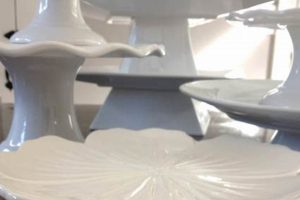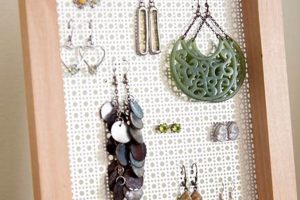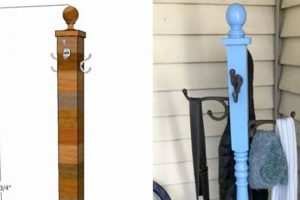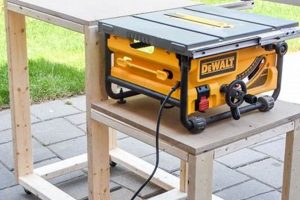The creation of a custom support structure for aquatic habitats involves individual design and construction. This approach allows for tailored solutions specific to a tank’s dimensions and the surrounding environment. Assembled using readily available materials and common tools, these structures offer an alternative to commercially manufactured options.
Constructing a support offers multiple advantages. The primary benefit lies in cost savings, as materials often cost less than purchasing a pre-made alternative. Furthermore, it presents an opportunity to personalize the appearance and integrate specific features, such as storage solutions or aesthetic enhancements, that align with individual preferences and interior design. Historically, crafting bespoke furniture has been a standard practice, reflecting a tradition of resourcefulness and customization.
The following sections will delve into the considerations involved in building a stable and aesthetically pleasing support, including material selection, design principles, and step-by-step construction methods. Emphasis will be placed on ensuring structural integrity and long-term durability.
Essential Considerations for Custom Aquatic Habitat Supports
The following points address critical aspects of constructing a bespoke platform for an aquarium, intended to ensure both safety and longevity.
Tip 1: Material Selection: Employ construction-grade lumber, prioritizing kiln-dried options to minimize warping and ensure dimensional stability. Avoid particleboard or MDF for structural components, as they are susceptible to water damage and possess insufficient load-bearing capacity.
Tip 2: Structural Integrity: Design with a substantial safety margin, exceeding the anticipated weight of the filled aquarium. Implement robust joinery techniques, such as pocket screws, mortise and tenon, or half-lap joints, to maximize strength and prevent racking.
Tip 3: Leveling: Ensure the support is perfectly level before placing the aquarium. Uneven weight distribution can induce stress on the glass panels, potentially leading to leaks or catastrophic failure. Utilize shims as needed to achieve a perfectly flat surface.
Tip 4: Moisture Protection: Apply a waterproof sealant or paint to all exposed wood surfaces, particularly those in proximity to the aquarium. This preventative measure mitigates the risk of water damage and prolongs the structure’s lifespan.
Tip 5: Load Distribution: Incorporate a plywood top spanning the entire frame to distribute the aquarium’s weight evenly. This minimizes point loads and reduces the likelihood of localized stress concentrations.
Tip 6: Ventilation: Design the structure to allow for adequate airflow around the aquarium’s filtration equipment. This prevents overheating and ensures optimal performance of the associated components.
Tip 7: Aesthetics: Integrate design elements that complement the surrounding decor while maintaining structural integrity. Consider adding trim, paint, or stain to achieve the desired aesthetic effect.
Adhering to these recommendations will contribute to the creation of a reliable and visually appealing platform for aquatic displays. Prioritizing structural soundness and moisture resistance are paramount for a long-lasting and secure result.
The subsequent sections will explore specific designs and construction methodologies to assist in the practical implementation of these considerations.
1. Material Load Capacity
Material Load Capacity is a paramount concern in the context of self-constructed aquatic habitat supports. The ability of the chosen material to withstand the immense weight of a filled aquarium directly influences the stability and safety of the entire setup. Insufficient load capacity presents a risk of structural failure, potentially leading to significant damage and loss of aquatic life.
- Wood Species and Density
Different wood species possess varying densities and inherent strengths. Hardwoods such as oak or maple exhibit greater load-bearing capabilities compared to softwoods like pine. The selection of an appropriate wood species, coupled with an understanding of its density, is crucial for ensuring adequate structural support. For example, a pine frame might suffice for a smaller aquarium, while a larger tank necessitates the use of oak or a similar high-density hardwood. The density directly correlates with the ability to resist deformation under load.
- Lumber Dimensions and Span
The dimensions of the lumber used in construction directly impact its load-bearing capacity. Thicker and wider boards offer greater resistance to bending and deflection under weight. The unsupported span, or the distance between supporting members, also plays a critical role. Longer spans require thicker lumber to prevent sagging or collapse. For instance, a 2×4 stud spanning a short distance may be adequate, but a wider span would necessitate a larger dimension, such as a 2×6 or 2×8, to maintain structural integrity.
- Joint Strength and Construction Techniques
The method by which individual pieces of lumber are joined significantly affects the overall load capacity of the assembled structure. Weak joints can become points of failure under stress. Employing robust joinery techniques, such as mortise and tenon, half-lap, or pocket screws, enhances the structural integrity and distributes the load more effectively. A poorly constructed joint, even with high-capacity lumber, can compromise the entire framework. The choice of fastener and the quality of the joinery are as important as the material itself.
- Safety Factors and Design Overengineering
Incorporating a safety factor into the design is essential to account for unforeseen stresses or imperfections in the materials. Overengineering the structure by selecting materials with a significantly higher load capacity than theoretically required provides an added margin of safety. This buffer reduces the risk of failure due to unexpected loads or material degradation over time. Applying a safety factor ensures that the structure can withstand not only the static weight of the aquarium but also dynamic stresses such as movement or vibrations.
The interplay of wood species, lumber dimensions, joint strength, and safety factors collectively determines the material load capacity of a custom aquatic habitat support. A comprehensive understanding of these facets is indispensable for constructing a safe, stable, and durable platform for any aquarium. Neglecting any of these aspects can compromise the integrity of the entire structure and potentially lead to disastrous consequences. Therefore, careful consideration of material load capacity is not merely a design consideration but a fundamental safety imperative.
2. Structural Joint Stability
The integrity of a custom-built aquatic habitat support hinges significantly on the stability of its structural joints. These joints, the connections between individual components, serve as critical load-bearing points. Failure in these joints, due to inadequate design or construction, precipitates structural collapse, inevitably endangering the aquarium and its contents. The effect is a direct correlation: weakened joints lead to compromised support. A primary cause of joint instability is the selection of inappropriate joinery methods or the use of insufficient fasteners, such as screws or adhesives that are inadequate for the sustained load. The importance of robust joint construction cannot be overstated; it is a fundamental determinant of the support’s overall safety and longevity.
Consider the common scenario of a frame constructed using butt joints secured only with screws. While seemingly straightforward, this method offers minimal resistance to racking forces the forces that cause the frame to twist or distort. Over time, the screws may loosen, further weakening the joints and increasing the risk of failure. In contrast, employing more robust joinery techniques, such as mortise and tenon, half-lap joints, or even pocket screws used in conjunction with wood glue, distributes the load more evenly and provides greater resistance to racking. These methods effectively increase the surface area of the connection, thereby enhancing its strength and stability. The practical significance of understanding this lies in the ability to proactively select and implement construction methods that minimize the risk of joint failure, ensuring a durable and reliable aquatic habitat support. For example, a larger aquarium, exceeding 100 gallons, demands significantly stronger joint construction compared to a smaller desktop tank. Ignoring this distinction can lead to catastrophic results.
In conclusion, structural joint stability is a non-negotiable element in the construction of a custom aquatic habitat support. The challenges inherent in ensuring joint integrity necessitate a thorough understanding of joinery techniques and load-bearing principles. By prioritizing robust joint construction, the risk of structural failure is significantly reduced, guaranteeing a secure and stable environment for the aquarium and its inhabitants. This fundamental understanding directly contributes to the success of the project, transforming the construction of a support from a potential hazard into a reliable foundation.
3. Moisture Resistance
The longevity and structural integrity of a custom-built aquatic habitat support are inextricably linked to its resistance to moisture. As water is a constant presence in aquarium keeping, the support structure is perpetually exposed to spills, condensation, and humidity, creating an environment conducive to material degradation. The porous nature of wood, the primary material used, renders it susceptible to water absorption, leading to swelling, warping, and ultimately, structural weakening. Failure to adequately address moisture resistance during construction invariably results in premature decay and a compromised support system. An example includes the gradual disintegration of an unprotected wooden stand situated in a humid environment near a saltwater aquarium; salt spray accelerates corrosion. Understanding this causal relationship is paramount in ensuring the durability of the stand.
Effective moisture resistance strategies involve a multi-pronged approach. The application of waterproof sealants or paints to all exposed wood surfaces provides a protective barrier against water penetration. These coatings effectively impede water absorption, preventing dimensional changes and minimizing the risk of rot and fungal growth. Furthermore, selecting water-resistant materials, such as pressure-treated lumber or composite decking, can significantly enhance the stand’s ability to withstand prolonged exposure to moisture. Designing the support with adequate ventilation also aids in moisture control by promoting air circulation and preventing the accumulation of humidity within the structure. A properly sealed and ventilated structure actively combats the deleterious effects of moisture, extending its lifespan and maintaining its structural integrity. Applying multiple coats of marine-grade varnish, for example, greatly increases the support’s moisture barrier compared to a single coat of standard interior paint.
In conclusion, moisture resistance is not merely a supplementary feature but a fundamental requirement in the design and construction of a custom aquatic habitat support. Neglecting this aspect precipitates material degradation and ultimately jeopardizes the stability of the entire system. By implementing comprehensive moisture control strategies, including the application of waterproof coatings, the selection of resistant materials, and the provision of adequate ventilation, the lifespan and reliability of the support are substantially enhanced. This proactive approach ensures the long-term security and stability of the aquatic environment, mitigating the risk of structural failure and preserving the aesthetic appeal of the setup. The understanding and implementation of robust moisture resistance measures are therefore indispensable for successful aquarium keeping.
4. Level Surface Accuracy
Precise leveling of a support structure is paramount in the construction of bespoke aquatic habitats. Deviations from a perfectly horizontal plane can induce disproportionate stress on the aquarium’s glass or acrylic panels, potentially leading to leaks, cracking, or catastrophic failure. Therefore, achieving and maintaining accurate levelness is not merely an aesthetic consideration but a fundamental safety requirement.
- Stress Distribution
An unlevel surface causes unequal distribution of the aquarium’s weight. High spots bear a greater load, creating stress concentrations on the tank’s bottom panel. For example, a slight dip in the center of the support concentrates the weight along the edges, while an elevated corner causes the opposite effect. This uneven distribution weakens the structure over time and heightens the risk of structural failure. The consequences can extend to property damage and loss of aquatic life.
- Material Fatigue
Constant stress from an unlevel surface leads to material fatigue, particularly in glass or acrylic. Repeated cycles of stress and relaxation weaken the molecular bonds within the material. Minor imperfections or pre-existing flaws become exacerbated, accelerating the onset of cracks or fissures. Even minor deviations from a perfectly level surface can accumulate over time, compromising the structural integrity of the aquarium.
- Shim Usage and Limitations
Shims are often employed to correct minor level discrepancies; however, their usage has limitations. Excessive reliance on shims indicates a fundamental flaw in the support’s construction and compromises long-term stability. Shims can compress or shift over time, leading to a gradual loss of levelness. Ideally, shims should only be used for fine adjustments after the primary support structure is as level as possible. Placing shims strategically under the support’s legs can correct minor imperfections.
- Measurement Tools and Techniques
Accuracy in leveling necessitates the use of appropriate measurement tools and techniques. A high-quality spirit level or laser level provides precise readings, enabling accurate adjustments. Careful attention to detail is crucial; repeatedly checking the level in multiple directions ensures the surface is level in all planes. Failure to accurately measure and correct level deviations undermines the entire construction process. Precise measurements are indispensable for a stable and safe outcome.
The cumulative effect of these facets underscores the critical role of level surface accuracy. Without a perfectly level base, even the most robust and aesthetically pleasing support structure is inherently flawed. The integration of precise measurement, careful construction, and strategic shimming, within acceptable limitations, ensures the stability and longevity of the aquatic display, safeguarding against potential hazards. Emphasis should be given to the underlying structure of fish tank stand diy.
5. Design Aesthetics
The visual appeal of an aquatic habitat’s support structure directly influences its integration into the surrounding environment. The cause-and-effect relationship is straightforward: a well-designed support enhances the aesthetic value of both the aquarium and the room it occupies, while a poorly designed support detracts from the overall appearance. This interaction underscores the significance of design aesthetics as a critical component of custom aquarium support construction. Neglecting aesthetic considerations diminishes the impact of the aquarium as a focal point, rendering it a visual afterthought rather than a carefully curated display. For example, a sleek, minimalist support constructed from dark-stained wood complements a modern living space, while a rustic, reclaimed wood support aligns with a more traditional or bohemian dcor. The practical significance of this understanding lies in the ability to create a cohesive and visually pleasing environment.
Furthermore, design aesthetics extends beyond mere surface appearances. It encompasses the integration of functional elements, such as concealed filtration systems, hidden wiring, and convenient storage solutions, into the overall design. A well-conceived design seamlessly blends these functional requirements with aesthetic considerations, resulting in a support structure that is both visually appealing and highly practical. For instance, a support incorporating concealed compartments for housing a canister filter and CO2 system eliminates unsightly equipment, maintaining a clean and uncluttered appearance. The careful selection of materials, finishes, and hardware further contributes to the overall aesthetic. Choosing brushed nickel hardware over polished brass, or opting for a matte finish instead of a glossy one, subtly alters the visual impact of the support. These nuances in design contribute to the overall aesthetic.
In conclusion, design aesthetics are not superficial embellishments but integral elements in the construction of a custom aquatic habitat support. The visual integration of the support with the surrounding environment, the seamless incorporation of functional elements, and the careful selection of materials and finishes collectively determine the overall aesthetic appeal. Prioritizing design aesthetics transforms the support from a utilitarian structure into a visually pleasing and functional component of the aquatic display. The challenges lie in balancing aesthetic considerations with structural integrity and practical functionality. However, the rewards of a well-designed support are substantial, creating a harmonious and visually captivating focal point within the living space, and the structure is the focus of the fish tank stand diy creation.
6. Ventilation Adequacy
Proper air circulation within a custom-built aquatic habitat support, commonly referred to as “fish tank stand diy,” is essential for the operational efficiency and longevity of associated equipment. The enclosed nature of these structures can trap heat and moisture, leading to overheating of components such as pumps, filters, and lighting systems. Therefore, ventilation adequacy is not merely a design consideration but a functional necessity.
- Heat Dissipation
Electronic components generate heat as a byproduct of their operation. Inadequate ventilation hinders heat dissipation, causing components to overheat and potentially malfunction. High temperatures reduce the lifespan of electronic equipment and can lead to premature failure. An example is a canister filter pump operating within an enclosed, unventilated compartment. The trapped heat accelerates wear and tear on the motor, shortening its operational life. Effective ventilation allows for the convective removal of heat, maintaining components within their optimal operating temperature range.
- Moisture Control
Evaporation from the aquarium introduces moisture into the enclosed space of the support structure. Trapped moisture fosters the growth of mold and mildew, which can damage the wood or metal components of the structure. Furthermore, high humidity can accelerate corrosion of electrical connections and metal parts. Ventilation facilitates the removal of excess moisture, preventing the development of these detrimental conditions. Incorporating ventilation openings or fans promotes air circulation, minimizing moisture buildup.
- Equipment Accessibility
While not directly related to air circulation, ventilation considerations often overlap with equipment accessibility. Openings designed for ventilation can also serve as access points for maintenance and adjustments. Strategic placement of ventilation allows for easy access to pumps, filters, and other equipment, streamlining maintenance procedures and reducing the need for complete disassembly of the support structure. This integrated approach to design enhances both functionality and convenience.
- Component Placement Impact
The placement of equipment within the stand is a factor. High heat sources and electrical components should be placed near or directly under ventilation sources such as exhaust fans or vents, while moisture sensitive equipment should be kept away from the tank and given additional ventilation as well. This can involve adding additional directional ventilation fans, or adjusting the design to create better airflow and air exchange within the stand.
These combined facets of heat dissipation, moisture control, equipment accessibility, and component placement highlight the integral role of ventilation adequacy within the context of “fish tank stand diy.” Proper implementation of ventilation strategies safeguards the equipment, preserves the structural integrity of the support, and simplifies maintenance procedures. The integration and design of ventilation should be done within the primary structural integrity constraints and design criteria from the previous discussions.
Frequently Asked Questions
The following addresses commonly encountered inquiries regarding the construction and implementation of custom support structures for aquariums.
Question 1: Is it more cost-effective to construct a support structure versus purchasing a commercially manufactured option?
Material costs for constructing a support are often less than the purchase price of a commercially available stand. However, the labor involved, coupled with the potential for errors and material waste, should be factored into the cost analysis. Individuals lacking carpentry skills or access to necessary tools may find a commercially available option more practical from a cost perspective.
Question 2: What types of wood are most suitable for constructing an aquarium support structure?
Hardwoods, such as oak and maple, offer superior strength and resistance to warping compared to softwoods like pine. Pressure-treated lumber provides enhanced protection against moisture damage, but potential leaching of chemicals into the aquarium water should be carefully considered. Kiln-dried lumber minimizes the risk of warping and dimensional instability.
Question 3: What are the critical design considerations for ensuring structural integrity?
Design considerations must account for the total weight of the filled aquarium, including water, substrate, decorations, and equipment. Employing a safety factor exceeding the calculated weight is advisable. Robust joinery techniques, such as mortise and tenon joints or pocket screws used in conjunction with wood glue, enhance structural stability. A level surface is also imperative to evenly distribute weight and prevent stress concentrations.
Question 4: How can water damage to the support structure be prevented?
Application of waterproof sealants or paints to all exposed wood surfaces provides a protective barrier against moisture penetration. Ensuring adequate ventilation within the support structure minimizes humidity and prevents moisture buildup. Regular inspection and maintenance, including prompt cleanup of spills, also contribute to preventing water damage.
Question 5: What tools are essential for constructing a custom aquarium support structure?
Essential tools include a measuring tape, level, saw (circular saw or hand saw), drill, screwdriver, and sander. Clamps are useful for securing joints during assembly. Safety glasses and a dust mask are recommended for personal protection.
Question 6: What safety precautions should be taken during construction?
Appropriate safety gear, including safety glasses, a dust mask, and work gloves, should be worn at all times. Power tools should be used in accordance with manufacturer instructions. Ensure adequate ventilation when working with paints, sealants, or adhesives. Exercise caution when lifting heavy materials to prevent injury.
Adhering to these recommendations and considerations will contribute to a safe, stable, and aesthetically pleasing aquatic habitat support. Prioritizing structural integrity and moisture resistance remains paramount for long-term reliability.
The next section will delve into advanced design strategies and customization options.
Conclusion
The preceding sections have comprehensively examined critical facets of constructing a bespoke aquatic habitat support. Topics covered encompass material selection, structural integrity, moisture resistance, level surface accuracy, design aesthetics, and ventilation adequacy. Successfully navigating these considerations is essential for ensuring the creation of a safe, stable, and visually pleasing platform for aquatic displays. A properly executed structure mitigates risks associated with structural failure, water damage, and equipment malfunction.
Given the complex interplay of structural, functional, and aesthetic elements inherent in the construction of a “fish tank stand diy,” diligent planning and precise execution are paramount. Future endeavors in this area should focus on integrating advanced materials and innovative design techniques to further enhance structural integrity and simplify construction processes. Continued emphasis on safety protocols and adherence to best practices remains crucial for the successful creation of custom aquatic habitat supports.







